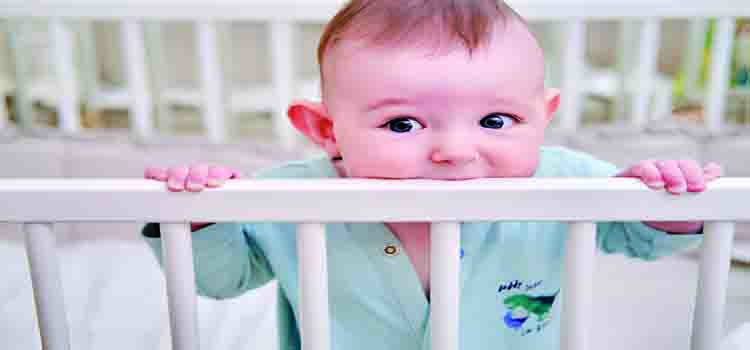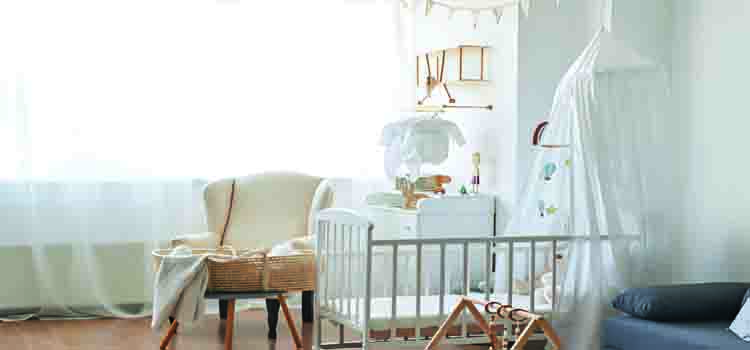As an Amazon Associate I earn from qualifying purchases.
Babies are naturally attracted to putting the world in their mouths. Popular in Advice Advertisement There are issues all parents can relate to, however, and one of the most common happens when baby begins to chew on the crib. It can be annoying and even downright concerning when there’s some kind of destruction to the crib or the child could be in danger. How to stop baby from chewing on crib: So now that you know the possible reasons why babies prefer to indulge in crib tasting, let’s take a look at how we can fix this. There are a number of easy ways that parents can ensure they are protecting their baby’s health and helping to keep their nursery in good shape.

Why Do Babies Chew on Cribs?
Before getting into the how, it is important to cover the why. Babies are not gnawing on cribs to irritate you or damage perfectly good furniture. The most common causes of such behavior are:
Teething Discomfort
Teething is a big deal for babies, but unfortunately the window during which most babies teeth is also their first experience with sore, swollen gums. Biting down on hard objects such as crib rails is temporary help as it puts the necessary pressure on their swollen gums.
Exploration
Babies are curious by nature, and they explore the world with their mouths. A crib rail may have an unusual texture that is new or interesting, and they might put it in their mouth as a novelty.
Boredom or Stress
In some cases, crib biting is a symptom of boredom or stress. During this time, your baby will be in their crib a ton, they may gnaw or do it for stimulation or comfort.
Easier Reach
Though toys or teething rings can drop out of your baby’s grasp, the slats on the crib are easy for a baby to reach at all times, making them a favorite chewing spot.
Having understood why do you nibble on your nails, let’s see the dangers of this habit.
Risks of Babies Chewing on Cribs
Although crib chewing is common, it’s not entirely harmless. Here are some risks you should be aware of:
- Chemical Treatments: Several cribs are painted or finished with chemicals, marked as baby-friendly or not. Chewing may also lead to the ingestion of tiny amounts of these substances.
- Splinters: If the crib is made of wood, your baby may get splinters in their mouth or gums.
- Teeth: Constant chewing on a hard surface can cause damage to the teeth, such as chipping or misalignment.
- Damaging Furniture: As minor as the safety hazards are to your child, crib chew can create nasty bite marks in your cribs, so why not extend the life of this precious investment.
Now that you’re equipped with the knowledge, here are some actionable steps to stop your baby from chewing on the crib.
How to Stop Baby from Chewing on Crib

For most parents, the struggle of their babies chewing on their cribs is all too real. This sort of conduct is typical, but it’s also troubling. Babies gnaw on cribs because they’re teething, curious about the world or bored. Understanding why babies do this, and how to stop them, can help save their health and keep your crib intact.
We’ll learn seven effective ways of how to stop babies from chewing on their cribs! These are safe, easy and effective techniques.
Use a Crib Rail Cover
Crib rail covers are one of the simplest and most effective solutions for stopping your baby from gnawing on their crib.
- What it is: A crib rail cover is a fabric or plastic protector that wraps around the top rail of the crib.
- Benefits:
- Prevents your baby from getting hurt by splinters or ingesting paint.
- Protects the crib rails from damage.
- Easy to clean and many come in various colors or designs to match your nursery.
- How to use it:
Install a crib rail cover securely according to the manufacturer’s instructions. Look for BPA-free and non-toxic options to ensure safety.
If you’re crafty, you can even make your own rail covers with soft fleece fabric!
Offer Safe Teething Alternatives
If you want to stop the baby chewing on the crib, provide a safer chewing alternative for your baby.Teething toys are designed for this purpose. Choose options made from non-toxic materials and that are easy to clean.
Offering alternatives ensures that your baby still gets the comfort they need without the risks associated with crib chewing.
- What to provide:
- Silicone or rubber teething toys.
- Chilled or frozen teething rings for added gum relief (just ensure they’re safe and don’t leak when punctured).
- Wooden or natural-material teethers, ensuring they are non-toxic and smooth to avoid splinters.
- Tips:
- Keep a variety of textures available to keep them interested.
- Regularly clean and sanitize teething toys to prevent the buildup of germs.
When your baby starts chewing on the crib, gently redirect them to their teething toy as often as needed.
Try a Natural Remedy: Chamomile or Herbal Teething Tablets
Now and then, you can also do your part to help soothe your baby’s teething pain naturally. Chamomile tea is often used to soothe, and it can be offered in very small amounts to baby, but be sure you check with your pediatrician first.
Likewise, herbal teething tablets containing safe ingredients may provide relief. But call a health care professional first before doing anything.
These natural teething remedies can help to relieve the pain of teething, helping to prevent crib gnawing.
Provide Extra Comfort
Comfort is a must when teething. A soothing bedtime ritual will help you baby feel safe and less anxious.
Also try an infant teething gel! These gels will all help to anesthetize gums and allow for temporary relief from teething pain. Once again, be sure to use what pediatricians approve.
Consistent routine matters a lot in comforting your baby and reducing the needs of chewing.
Keep Baby’s Mouth Busy with Distractions
Providing distractions is also another way to block it. Offer your baby soft toys or things to chew that are okay for him to sink his teeth into.
A busier baby is less likely to chew on the crib. Entertain your baby with toys that make noise or have unique textures so you can keep his/her interest off the crib.
Keeping them active is key to keeping them away from chewing on the crib.
Infants might chew on the crib because they are bored or in a searching comfort. Distract them with something else and take their mind off it.
- When to distract:
- If you notice your baby chewing during playtime, offer more interactive toys, tummy time, or sensory activities.
- During nighttime or nap time, try providing a lovey or a soft, safe stuffed animal to comfort them.
- How to redirect:
- Carefully remove their mouth from the crib rail and redirect their focus to an acceptable object, like a teether.
- Be consistent and patient, as this behavior takes time to correct.
Make Sure the Crib Is Teething-Safe
It’s important to select a teething-safe crib. Opt for cribs with non-toxic finishes. Teething baby cribs are often designed with a protective coating or chew-safe materials.
You should also look into buying a crib that has teething rails already incorporated into it. These rails are constructed of safe materials and were designed to protect the rest of your crib from damage.
You can minimize the risk of crib damage and maximize it being chewed on safe materials by choosing a teething-safe crib.
If your baby is still chewing on the crib, check out the crib’s safety features.
- What to look for:
- Ensure paint and finishes are non-toxic and safe for infants.
- Replace older cribs with new models that meet current safety standards, especially since some old cribs may have lead-based paint or other hazardous materials.
- Extra precaution:
- Sand down any rough edges on wooden cribs to prevent splinters.
- Avoid attaching objects (like bumpers) to the crib to deter chewing, as they may pose suffocation risks.
Be Consistent with Correction
If your baby persists in gnawing on the crib, divert their attention with a chew-compatible toy. Gently redirect their hands away from the crib and give them a teething toy instead.
Patience is key. Your baby may continue to chew on the crib for some time, but through a process of redirection, such behaviour can be unlearned.
When to Consult a Pediatrician
If your baby’s teething becomes overwhelming or if you notice signs of extreme discomfort, it may be time to consult a pediatrician. A healthcare professional can recommend the best course of action if your baby’s teething issues seem more severe than usual.
A Final Word on Curiosity and Comfort
Infants learn about their environment by exploring it, and chewing is just one of the ways they do that. Though crib chewing is a normal phase, it is something you will want to deal with to keep your little one safe and happy.
With the tips discussed above, you can gradually guide your baby’s chewing addiction ensuring your baby and furniture are safe. And as we know, all babies are different, so it may take a mix of these methods to find what is best for your family.
If you want more parenting tips or product recommendations for getting through all the stages of your baby’s development, you’ll definitely want to check out our blog for more great tips and solutions!
FAQs: How to Stop Baby from Chewing on Crib
Babies chew to explore, relieve teething discomfort, or seek comfort during developmental stages.
Use teething toys, apply crib rail protectors, and ensure the crib is clean and safe for chewing.
Yes, crib rail protectors are safe and provide a soft barrier, protecting both the baby and the crib.
Most babies stop chewing around 18-24 months when teething pain decreases and they develop other coping mechanisms.
Yes, if the paint or wood splinters, it can pose a choking hazard. Ensure the crib is safe.
Consult your pediatrician for safe and effective teething remedies like chilled teething rings or a wet washcloth.
Amazon and the Amazon logo are trademarks of Amazon.com, Inc, or its affiliates.
Leave a Reply